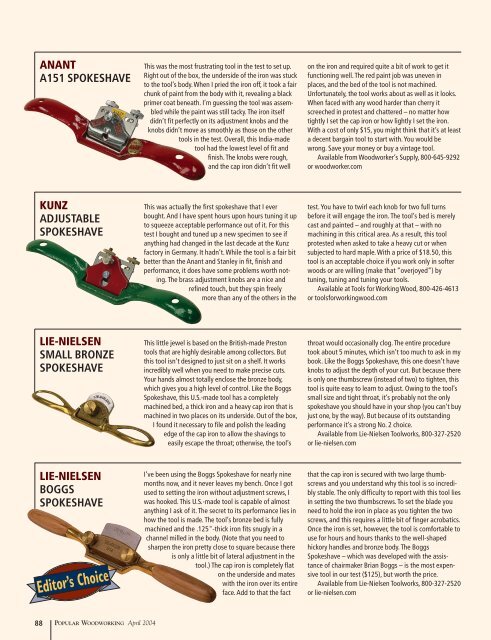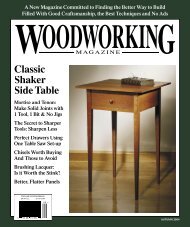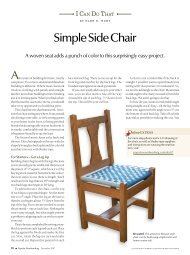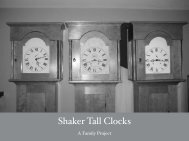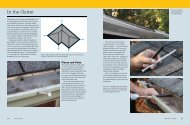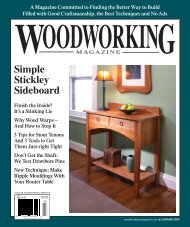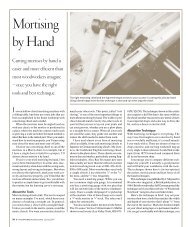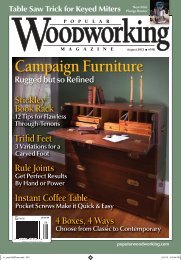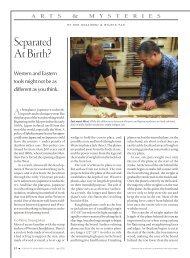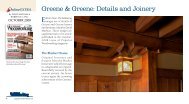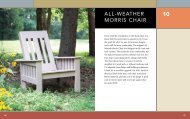anant a151 spokeshave - Popular Woodworking Magazine
anant a151 spokeshave - Popular Woodworking Magazine
anant a151 spokeshave - Popular Woodworking Magazine
Create successful ePaper yourself
Turn your PDF publications into a flip-book with our unique Google optimized e-Paper software.
ANANT<br />
A151 SPOKESHAVE<br />
KUNZ<br />
ADJUSTABLE<br />
SPOKESHAVE<br />
LIE-NIELSEN<br />
SMALL BRONZE<br />
SPOKESHAVE<br />
LIE-NIELSEN<br />
BOGGS<br />
SPOKESHAVE<br />
88<br />
POPULAR WOODWORKING April 2004<br />
This was the most frustrating tool in the test to set up.<br />
Right out of the box, the underside of the iron was stuck<br />
to the tool’s body.When I pried the iron off, it took a fair<br />
chunk of paint from the body with it, revealing a black<br />
primer coat beneath. I’m guessing the tool was assembled<br />
while the paint was still tacky.The iron itself<br />
didn’t fit perfectly on its adjustment knobs and the<br />
knobs didn’t move as smoothly as those on the other<br />
tools in the test. Overall, this India-made<br />
tool had the lowest level of fit and<br />
finish.The knobs were rough,<br />
and the cap iron didn’t fit well<br />
This was actually the first <strong>spokeshave</strong> that I ever<br />
bought. And I have spent hours upon hours tuning it up<br />
to squeeze acceptable performance out of it. For this<br />
test I bought and tuned up a new specimen to see if<br />
anything had changed in the last decade at the Kunz<br />
factory in Germany. It hadn’t. While the tool is a fair bit<br />
better than the Anant and Stanley in fit, finish and<br />
performance, it does have some problems worth noting.<br />
The brass adjustment knobs are a nice and<br />
refined touch, but they spin freely<br />
more than any of the others in the<br />
This little jewel is based on the British-made Preston<br />
tools that are highly desirable among collectors. But<br />
this tool isn’t designed to just sit on a shelf. It works<br />
incredibly well when you need to make precise cuts.<br />
Your hands almost totally enclose the bronze body,<br />
which gives you a high level of control. Like the Boggs<br />
Spokeshave, this U.S.-made tool has a completely<br />
machined bed, a thick iron and a heavy cap iron that is<br />
machined in two places on its underside. Out of the box,<br />
I found it necessary to file and polish the leading<br />
edge of the cap iron to allow the shavings to<br />
easily escape the throat; otherwise, the tool’s<br />
I’ve been using the Boggs Spokeshave for nearly nine<br />
months now, and it never leaves my bench. Once I got<br />
used to setting the iron without adjustment screws, I<br />
was hooked. This U.S.-made tool is capable of almost<br />
anything I ask of it. The secret to its performance lies in<br />
how the tool is made. The tool’s bronze bed is fully<br />
machined and the .125"-thick iron fits snugly in a<br />
channel milled in the body. (Note that you need to<br />
sharpen the iron pretty close to square because there<br />
is only a little bit of lateral adjustment in the<br />
tool.) The cap iron is completely flat<br />
on the underside and mates<br />
with the iron over its entire<br />
face. Add to that the fact<br />
on the iron and required quite a bit of work to get it<br />
functioning well.The red paint job was uneven in<br />
places, and the bed of the tool is not machined.<br />
Unfortunately, the tool works about as well as it looks.<br />
When faced with any wood harder than cherry it<br />
screeched in protest and chattered – no matter how<br />
tightly I set the cap iron or how lightly I set the iron.<br />
With a cost of only $15, you might think that it’s at least<br />
a decent bargain tool to start with.You would be<br />
wrong. Save your money or buy a vintage tool.<br />
Available from Woodworker’s Supply, 800-645-9292<br />
or woodworker.com<br />
test. You have to twirl each knob for two full turns<br />
before it will engage the iron. The tool’s bed is merely<br />
cast and painted – and roughly at that – with no<br />
machining in this critical area. As a result, this tool<br />
protested when asked to take a heavy cut or when<br />
subjected to hard maple. With a price of $18.50, this<br />
tool is an acceptable choice if you work only in softer<br />
woods or are willing (make that “overjoyed”) by<br />
tuning, tuning and tuning your tools.<br />
Available at Tools for Working Wood, 800-426-4613<br />
or toolsforworkingwood.com<br />
throat would occasionally clog.The entire procedure<br />
took about 5 minutes, which isn’t too much to ask in my<br />
book. Like the Boggs Spokeshave, this one doesn’t have<br />
knobs to adjust the depth of your cut. But because there<br />
is only one thumbscrew (instead of two) to tighten, this<br />
tool is quite easy to learn to adjust. Owing to the tool’s<br />
small size and tight throat, it’s probably not the only<br />
<strong>spokeshave</strong> you should have in your shop (you can’t buy<br />
just one, by the way). But because of its outstanding<br />
performance it’s a strong No. 2 choice.<br />
Available from Lie-Nielsen Toolworks, 800-327-2520<br />
or lie-nielsen.com<br />
that the cap iron is secured with two large thumbscrews<br />
and you understand why this tool is so incredibly<br />
stable. The only difficulty to report with this tool lies<br />
in setting the two thumbscrews. To set the blade you<br />
need to hold the iron in place as you tighten the two<br />
screws, and this requires a little bit of finger acrobatics.<br />
Once the iron is set, however, the tool is comfortable to<br />
use for hours and hours thanks to the well-shaped<br />
hickory handles and bronze body. The Boggs<br />
Spokeshave – which was developed with the assistance<br />
of chairmaker Brian Boggs – is the most expensive<br />
tool in our test ($125), but worth the price.<br />
Available from Lie-Nielsen Toolworks, 800-327-2520<br />
or lie-nielsen.com
STANLEY<br />
151 SPOKESHAVE<br />
VERITAS<br />
LOW-ANGLE<br />
SPOKESHAVE<br />
VERITAS<br />
SPOKESHAVE<br />
This tool, now made in England, is the genetic ancestor<br />
of the Kunz,Anant and one of the Veritas shaves.Too<br />
bad it has fallen on hard times.The Stanley 151 of old<br />
was a finer tool than this modern version.The fit and<br />
finish was better on the old models I’ve had in my<br />
shop, as was the fit between the body, iron and cap<br />
iron. In fact, the modern Stanley version has been<br />
eclipsed by the Veritas (which is far superior)<br />
and even the Kunz (which has<br />
nicer adjustment knobs). Like<br />
the other less-expensive<br />
shaves, the Stanley didn’t<br />
like to take a heavy cut or<br />
work in harder woods. If you<br />
were inclined, you could tune up the bed, replace the<br />
iron – a $25 to $33 investment – and make yourself a<br />
This hybrid tool has a lot of things going for it. Because<br />
it has the bevel facing up, it cuts at a low angle.This<br />
makes the tool easy to use even in hard woods and it is<br />
the best tool – hands-down – for shaping end grain. In<br />
fact, you can shave off ribbons of end grain when this<br />
Canadian-made tool is freshly sharpened – try that with<br />
any other metal shave. Because the tool’s body is cast<br />
aluminum, it’s lightweight (like a traditional wooden<br />
shave) but the throat won’t wear out like a<br />
traditional wooden shave is prone to<br />
because the body made of<br />
metal.The most unusual<br />
feature of the tool is<br />
its toe piece. It can be<br />
Lee Valley’s newest <strong>spokeshave</strong> does everything right.<br />
The body is cast from nearly unbreakable ductile iron<br />
with nicely fitted rosewood and brass handles. The bed<br />
of this Canadian-made tool is fully machined, resulting<br />
in an airtight fit between the iron and body. The brass<br />
adjustment screws fit into the notches on the iron<br />
perfectly with no discernable play or spinning – this<br />
results in an iron that is easy to set and stays set<br />
during your cut. The iron is .125" thick<br />
and made using A2 steel, which I<br />
personally prefer. The cap<br />
iron is a massive .20" thick<br />
and is machined on the<br />
bottom where it meets the<br />
new heavy cap iron. However, that reminds me of the<br />
joke about the guy who bought an old handsaw. He<br />
didn’t like the feel of the handle so he replaced it with a<br />
more comfortable handle.After using the saw for a bit<br />
he realized that the steel in the blade was junk and so<br />
he replaced that, too.The only original parts left were<br />
the saw’s nuts. If you like Stanley tools, I recommend<br />
you check antique stores, flea markets or eBay for a<br />
vintage 151.They are quite common and reasonably<br />
priced. In fact, you might find a specimen for less than<br />
the $23 you’d spend on a new version.While it’s a<br />
shame that this once-great manufacturer of quality<br />
hand tools is now more focused on garage-door openers,<br />
it’s the simple economics of the modern age.<br />
Available from Garrett Wade, 800-221-2942 or<br />
garrettwade.com<br />
turned over and reattached to the body, allowing the<br />
tool to be used on outside and inside curves.You set the<br />
depth of cut by adjusting the toe piece up and down,<br />
exposing more or less of the blade as needed.You also<br />
can shift the blade forwards and backwards in the body<br />
of the tool, regulating the tool’s throat.All-in-all, it’s a<br />
very adjustable tool.As mentioned earlier, the lower<br />
cutting angle means you have to pay closer attention to<br />
grain direction to avoid tear-out. If you build chairs<br />
(where straight-grained spindles are riven from logs)<br />
then this tool is ideal. It’s also great for any work that<br />
requires extensive shaping of end grain.<br />
Available from Lee Valley Tools, 800-871-8158 or<br />
leevalley.com<br />
iron and the top where the shavings escape. The throat<br />
is a good size for most general work. For woodworkers<br />
who prefer a tighter throat, the tool comes with two<br />
custom-fitted shims that you can place between the<br />
blade and the shave’s body. Overall the tool is a joy to<br />
use. The rosewood handles are quite comfortable (and<br />
I’m told there will be a kit offered soon that will allow<br />
you to make your own custom handles for this tool).<br />
The Veritas is easy to set and takes a fine or thick<br />
shaving without a hint of protest. Harder woods pose<br />
no problems for it. Priced at $65, this tool will become<br />
one of your best friends.<br />
Available from Lee Valley Tools, 800-871-8158 or<br />
leevalley.com PW<br />
popwood.com 89


